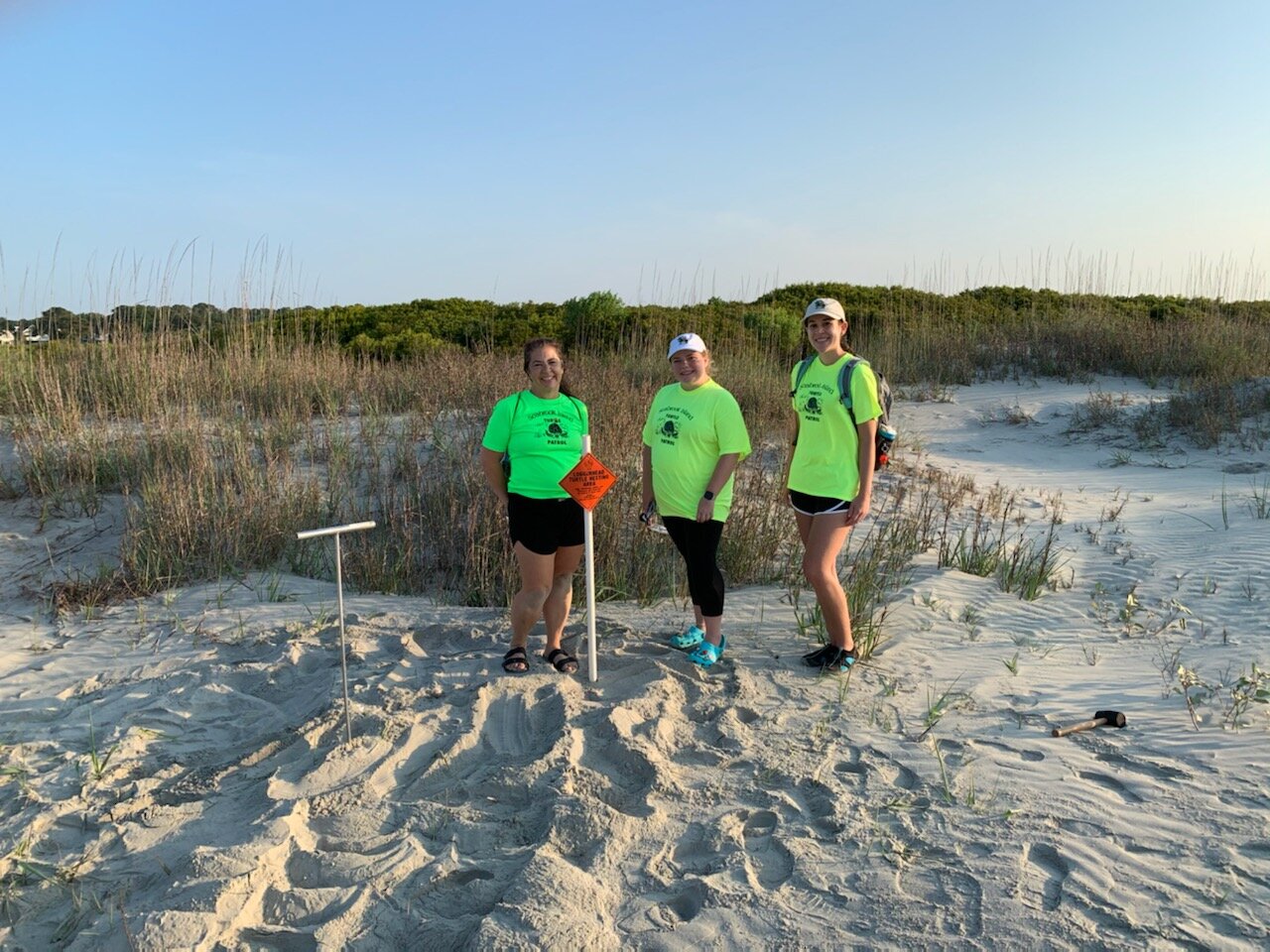Today's excitement started just as it became daylight when early morning beach goers had the privilege of watching a mama turtle return to the water after laying her eggs. Enough Turtle Patrol members were able to arrive at the scene, just North of Boardwalk 1 to keep the curious but respectful visitors from disturbing her long walk. After mama was safely back in the water, Mark and Valerie Doane followed her tracks to probe for eggs. They were surprised to find 2 eggs on top of the sand and wisely decided to hand dig Nest 12. Two more eggs were found an inch or so from the surface, then all the other eggs were located at a typical depth. The nest was below the high tide line and 125 eggs were relocated on Zone 4. Diane and John Woychick were our zone 4 walkers today.
Sea Turtles and Artificial Lighting
Artificial lighting, especially that which is on the beach-facing portion of coastal homes, is a major threat to sea turtles as it can cause disorientation for both nesting mothers and hatchlings. Since sea turtles orient toward the water using the relatively bright horizon of the sea, lighting from homes, streetlights, and other structures can draw turtles inland. Disoriented turtles waste precious energy, and for hatchlings, walking further into the dunes rather than towards the water means almost certain death via predators or due to heat as the sun rises. Further, bright lighting can deter nesting mother's from laying their eggs.
Many coastal towns have regulations that require lights to be turned out after a certain time during nesting season, as well as building requirements for new homes that include turtle-friendly lighting. Door and window vendors now offer "turtle glass" options for coastal homes that transmit 45% or less of visible light to the outside. Closing blinds and turning lights out completely after dark are of course a sure way to prevent light transmission. The Sea Turtle Conservancy provides some examples of sea turtle friendly lighting at the link below:
https://www.conserveturtles.org/beachfront-lighting-turtle-friendly-fixtures-lights/
Artificial lighting on structures is not the only source of disorienting light, however. Beachgoers with flashlights, fires on the beach, and lights from beach-adjacent roads and parking lots can also cause issues. Beachgoers can help by using only red flashlights on the beach, ensuring headlights are not focused on the beach and are off while parked, and by completely extinguishing fires before 10PM or earlier depending on local beach regulations. To learn more about the importance of keep our beaches dark, check out this video:
https://www.youtube.com/watch?v=wijgIlxFITA
Our turtle patrol team carries red flashlight covers in our beach vehicles. Please feel free to ask for one!
Be sure to check out this article about the changes our neighbors just to the South are doing to prevent sea turtle disorientation:
https://www.postandcourier.com/news/sc-beach-town-helps-sea-turtles-by-installing-less-distracting-lights/article_6e55628a-bfe3-11eb-9975-bbebd70fc8b9.html
Image Credit: Sea Turtle Conservancy
Nest 11
We now have 11 nests! Karen Sewell and Betsy Quinn walking Zone 2 called in the long, beautiful crawl. Joshua Shilko probed and found a nest of 132 eggs, which were relocated above the high tide line. Similar to our 'step nest' the other day, this mama bumped into a private boardwalk while finding the right spot to deposit her eggs.
Nest 10
Zone 4 got in on the action with Nest 10. J-Anna Smith, Anna Wechter and Annaliese Dorante called with a crawl 50 yards north of Boardwalk 1. Bill Greubel responded and found the nest which was able to be left in situ.
Tracking Turtles
Turtles live their entire lives at sea and historically we have only gotten short glimpses into their life cycle during nesting season and during off-shore encounters. As a result, our understanding of their lives at sea is still evolving. Thanks to recent technological advances in GPS tracking, this understanding is growing rapidly and, in some cases, the data is even being made available for the public in real time.
A recent study on juvenile Atlantic green sea turtles confirmed that they oriented towards the Sargasso Sea rather than drifting in the currents of the North Atlantic Gyre, confirming broad anecdotal data suggesting that this was the case.
https://news.mongabay.com/2021/05/for-atlantic-sea-turtles-sargasso-sea-is-home-during-the-lost-years/
This study built upon a 2014 study that examined the movements of juvenile western Atlantic loggerheads, which found that while some loggerheads stayed adrift in the currents of the North Atlantic Gyre, a little less than half detoured to take refuge in the sargassum, confirming the importance of the Sargasso Sea for multiple species.
https://royalsocietypublishing.org/doi/10.1098/rspb.2013.3039
While tracking juveniles provides insight into the "lost years," tracking adults provides important insights into travel between foraging grounds, nesting grounds, and nesting beaches. The Sea Turtle Conservancy tracks a large number of adult sea turtles which you can follow along with here:
https://www.conserveturtles.org/sea-turtle-tracking-active-sea-turtles/
Nesting loggerhead Phyllis is particularly interesting as she has recently traveled through our area on her way to the northern foraging grounds that are used by many of the turtles that nest in our region. Check her out here:
https://www.conserveturtles.org/stctrackingmap/?id=233
Photo Credit: Kate Mansfield





